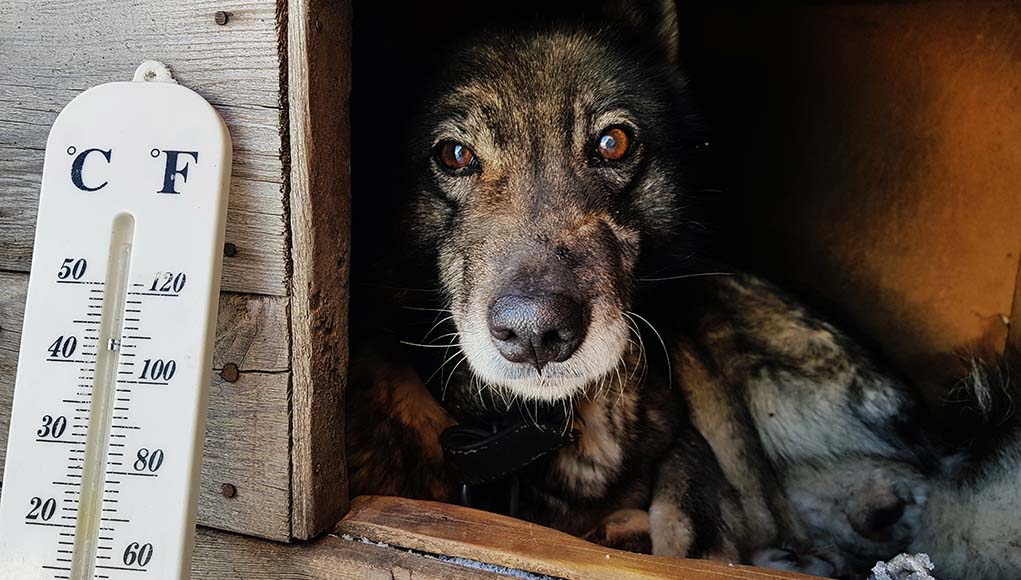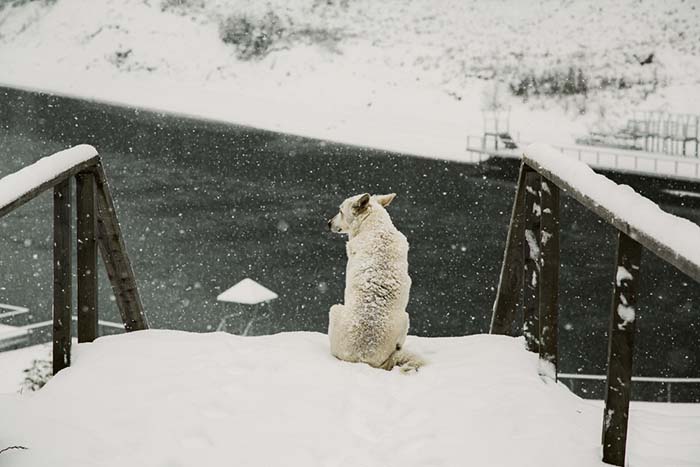Sometimes it seems that our dogs don’t care about the seasons, climate or outside temperature. While we will be moody on a rainy day, our dogs will be equally happy when they see us coming home from work whether it is sunny or cloudy. But even though they accept weather changes more easily psychologically, it doesn’t mean that they enjoy standing in the hot sun or cold blizzard.
There is a top and bottom safe outdoor temperatures for dogs, so let's talk about how you can protect your Fido in the weather which is defined as unsafe.
Temperature Matters
The safest option is to follow your own perception of temperature. If the weather is too hot or too cold for you, consider it to be the same for most dogs.
Just because your pet is happy to be playing outside doesn’t mean that the temperature is safe for them. Dogs cannot care for themselves in this regard, and won’t refuse taking a walk because of the temperature.
So if you need to wear a very thick coat, put some winter clothing on your dog too. If you are looking for shade outside because it’s too hot, take your pooch to the shade with you.
Wintertime
While many dogs will enjoy playing in the snow and even roll in it, they will not enjoy cold temperatures. Depending on where you live, it's crucial you understand what makes unsafe and safe outdoor temperatures for dogs.
Some breeds will bear the cold easier than others. For example, Siberian Huskies or Malamutes are obviously more adjusted to winter weather and they will enjoy it more than other breeds. Dogs with a thin coat or small breeds like Chihuahuas will not like winter that much due to the thinness of their coat, and will need extra clothing.
How Cold Is Too Cold?
Unsafe temperatures for dogs will vary in their stages:
At 0 degrees Celsius (32°F) is where it starts being unsafe.
At -6 degrees Celsius (21°F) it starts being dangerous.
At -13 degrees Celsius (8.6°F) it is life-threatening for dogs.
Once again, Huskies and other similar breeds that are naturally accepting of cold weather can withstand lower temperatures while thin coat breeds are at higher risk of freezing.
How to Protect Your Dog?
Even if the weather is cold, in most cases you still need to walk the dog. However, you should shorten the time spent outside or find a place which is protected from the cold wind, rain, snow.
During really cold winter days, it's recommended to put on winter coat on your dog (or any other alternative: vests, sweaters, blankets, etc.) before going outdoors. Also, if there is a lot of ice in the street, cover his paws with winter booties to protect them from being hurt, scratched or cut by ice. Some of them will also help with grip and traction.
If you have a balcony in your apartment or house, keep the door closed or limit the time your dog spends out there. When the pet is stationed in the yard and have their own house, make sure it's an insulated dog house to keep the cold away. You can also add a door which automatically closes as he gets in in order to protect him from snow and wind. Also, put blankets on the floor of the dog house and add extra insulation with cardboard. You may also use a dog house heater that is safe for pets.
Bear in mind that a dog’s body will need to spend more calories in winter due to adjusting to the cold outside temperature. Therefore, if your pup spends a lot of time outside when it's very cold, you need to give them a higher calorie meal before or after taking them outdoors.
What Are the Possible Consequences?
The consequences of dogs spending too much time in unsafe temperatures during cold winter weather are hypothermia and frostbites. While frostbites are painful, they are not as severe as hypothermia which can be life-threatening.
The symptoms of hypothermia in dogs are shivering, weakness, loss of appetite, lethargy, slow heartbeat, muscle stiffness and trouble breathing.
If you notice these signs, bring your pet indoors or to any warm place, cover them with a blanket and give him something warm to eat. It is a must to take the dog to the vet or call the vet to come to your location if the situation is serious. He will evaluate the dog's condition and advise you on further steps.
Summertime
The rules on safe outdoor temperatures for dogs don’t change during the summertime. The safest option is to follow reason: if you personally find it too hot outside, it will be too hot for your dog too. Bear in mind that if your pet has a thick coat like Huskies do, it will be even more exhausting and difficult for them in hot temperatures.
How Hot Is Too Hot?
The safe weather temperature during hot summer days largely depends on the humidity. For example, if your local climate is continental and the humidity is generally low, your pet will be just fine in up to 30 degrees Celsius (86°F).
On the other hand, if humidity is high, the temperature that the dog can bear will depend on the humidity level because the real feel would be a higher temperature than what the thermometer reads, and your pooch will get dehydrated and exhausted much faster.
How to Protect Your Dog?
Always bring a doggy water bottle of fresh water when going for a walk with your dog during summer. Choose the path surrounded by tall trees and more shade. On the hottest days, walk your dog early in the morning or late in the evening when the temperatures drop. Also, consider taking breaks in the cool, air-conditioned spaces, or walk your pet more times per day, but for a shorter duration.
Remember that as ice on the road can harm your dog’s paws, so can the hot pavement. Walking your dog on hot concrete can cause burns on his paws, so it may be best to change the route, or take him to the dog park instead, where there is a lot of grass.
In addition, you can also use dog booties to ensure your pet's paws don't get burned on hot concrete. And similarly to picking winter clothes, there are some great options of summer clothes to keep you pet cool. In particular, cooling dog vests are great.
Be careful not to leave your dog in the places insulated with glass where the temperature rises quickly like in an oven, such as balcony, glass house or car.
What Are the Possible Consequences?
The consequences of dogs spending too much time in the hot sun are dehydration, heat exhaustion and heatstroke.
Dehydration causes only temporary effects if fixed quickly and isn't as dangerous as the other two conditions. It is easy to cure with simply giving the dog liquids.
The symptoms of heat exhaustion are extreme thirst, weakness, muscle tremor, muscle cramps, disorientation, confusion, lack of interest for the things your dog usually likes to do, anxiety, dizziness, and slow heartbeat.
The symptoms of heatstroke are thirst, shortness of breath, muscle tremor, drooling, rapid heartbeat, blood in stool, disorientation and fainting.
If you notice any of these symptoms, move your dog to the shade and offer them fresh water. It’s a good idea to spray the dog with a little bit of water over their face and body, or use a dog pool if you have one. Just to be on the safe side, always take your pup to the vet for a check-up where he will receive the necessary medical care if needed.
Summary
Dogs are cheerful creatures who like to spend a lot of time outdoors playing, walking or running. Even though they cope with high or low temperatures psychologically better than us, physically they're are at a disadvantage. We should bear in mind that not all weather conditions are good for our pets.
In deciding on safest outdoor temperatures for dogs, we should follow our instinct and perception of the current weather conditions. If it is too cold or hot for us, the chances are high that it will be same for dogs.
Spending too much time in cold weather may cause frostbites and hypothermia, and spending a whole day in the hot sun may cause dehydration, heat exhaustion and heatstrokes. If you notice any of the symptoms of these conditions, the best option is to consult a vet immediately about further steps.
READ NEXT: When Is It Too Cold for Dogs to Be Outside?


















